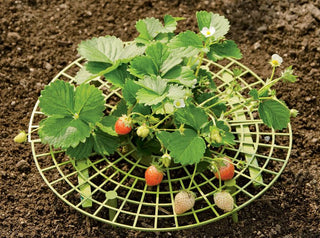How To Grow Strawberries: A Deliciously Rewarding Guide for Gardeners
Ah, the humble strawberry—small, red, and bursting with sweetness. Whether you're a seasoned green thumb or just dipping your toes into gardening, strawberries are an excellent choice for a fruitful and satisfying endeavor. Let's delve into the delightful world of growing these delectable fruits.
 Plant bareroot strawberries so the crown is level with the soil surface.
Plant bareroot strawberries so the crown is level with the soil surface.Types of Strawberries
- Everbearing strawberries produce two smaller crops: one in June (earlier in the South) and the other in late summer. Try 'Seascape' and 'Albion' varieties.
- June-bearing strawberries are the most familiar type and produce the largest fruits as well as large yields. June-bearing varieties also produce larger numbers of runners than ever-bearing varieties. Try 'Chandler' and 'Honeoye'.
- Day-neutral berries are not sensitive to the length of the day so they produce some berries all summer, with the possible exception of the hottest times. If you are planting a day-neutral variety, consider putting in twice as many plants to ensure that you can harvest more than a handful of berries at a time.
How To Propagate Strawberries
The recommended method for growing strawberries is through runners or divisions rather than starting from seed. However, if you're up for the challenge, starting from seeds requires patience. Begin indoors about 12-16 weeks before the last frost date and transplant seedlings outdoors after the threat of frost has passed.
Where To Plant Strawberries
Strawberries thrive in sunlight, basking in at least 6-8 hours a day. When it comes to soil, they prefer well-draining, slightly acidic soil. Amend the soil with compost for added nutrients and ensure good drainage to prevent waterlogged roots. Raised beds are ideal for growing strawberries; they promote fluffy, well-drained soil and help prevent invasion from weeds and grass.
How To Care For Strawberry Plants
Watering
Keep the soil consistently moist, especially during dry spells, but avoid overwatering as it can lead to root rot. Mulching around plants helps retain moisture and suppresses weeds.
Pruning
Regularly remove old or diseased leaves to encourage airflow and prevent diseases. Trim off runners to redirect the plant's energy into fruit production.
Fertilizing
Apply a balanced fertilizer every 2-4 weeks during the growing season to promote healthy growth and fruit production.
Staking and Supporting
Because of their low-growing, creeping runner form, strawberries are prone to rotting before they are ripe enough to harvest. Moist soil and heavy rain will exacerbate this problem. A light layer of straw mulch may temporarily help, however consider setting up a plastic or metal support underneath the plant to lift fruits up.
 Easy-to-install Strawberry Supports elevate berries to promote even ripening and minimize rot. Use in place of straw to decrease mold and slug damage.
Easy-to-install Strawberry Supports elevate berries to promote even ripening and minimize rot. Use in place of straw to decrease mold and slug damage.How To Harvest Strawberries
The moment of truth! Harvest ripe strawberries by gently plucking them from the stem, making sure to leave the green cap intact. Taste-test one or two while you're at it—freshly picked strawberries are simply irresistible. Strawberries should produce about a quart of berries per plant, per year.
Strawberry Pests and Problems
Pesky intruders like slugs, aphids, and spider mites can target your strawberries. Combat them by regularly inspecting plants and using organic pesticides if necessary. Diseases such as powdery mildew or botrytis can also plague strawberry plants; ensure proper airflow and consider fungicidal treatments if needed.
 3-Tier Strawberry Bed: This terraced planter is sized to fit 25 strawberry plants for a big yield in a small space.
3-Tier Strawberry Bed: This terraced planter is sized to fit 25 strawberry plants for a big yield in a small space.Strawberry FAQs
1. When is the best time to plant strawberries?
Plant in early spring or late summer for a fall harvest.
2. Why are my strawberry plants not fruiting?
Insufficient sunlight, overcrowding, or lack of nutrients might hinder fruit production. Check your plant's environment and make necessary adjustments.
3. How long do strawberry plants live?
With proper care, strawberry plants can produce fruit for about 3-5 years before needing replacement.
Embarking on a strawberry-growing adventure is immensely rewarding. With a bit of tender care and patience, you'll soon enjoy the fruits of your labor—a harvest of plump, juicy strawberries right from your garden. So, grab your gardening gloves and get ready for a deliciously fruitful journey!




